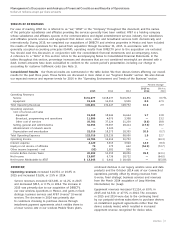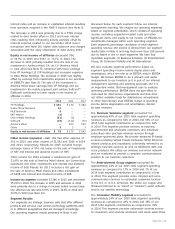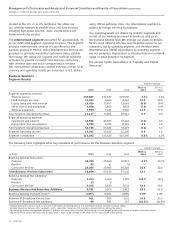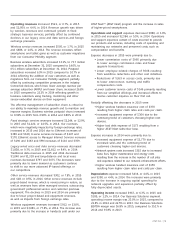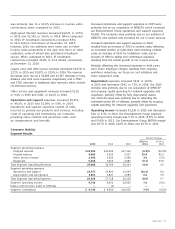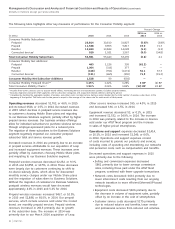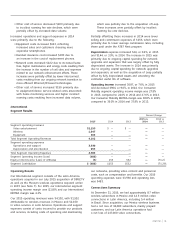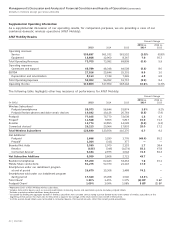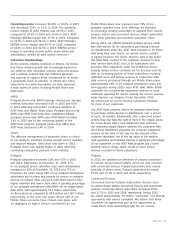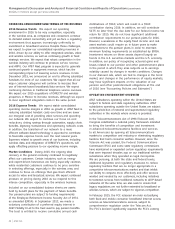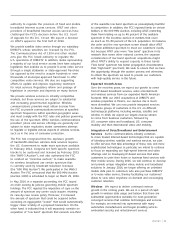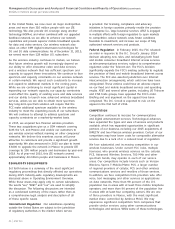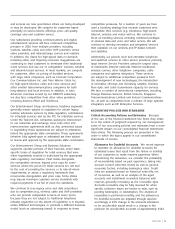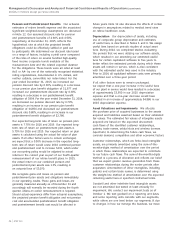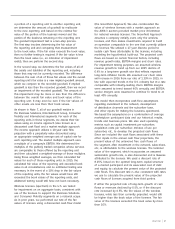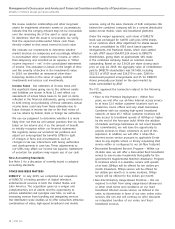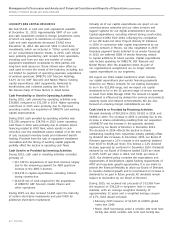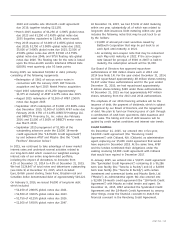AT&T Wireless 2015 Annual Report Download - page 23
Download and view the complete annual report
Please find page 23 of the 2015 AT&T Wireless annual report below. You can navigate through the pages in the report by either clicking on the pages listed below, or by using the keyword search tool below to find specific information within the annual report.
AT&T INC.
|
21
Operating income increased $1,903, or 10.6%, in 2015
and decreased $242, or 1.3%, in 2014. The operating
income margin of AT&T Mobility was 26.9% in 2015,
compared to 24.2% in 2014 and 26.0% in 2013. AT&T
Mobility’s EBITDA margin was 37.9% in 2015, compared
to 34.7% in 2014 and 36.3% in 2013. AT&T Mobility’s
EBITDA service margin was 46.7% in 2015, compared
to 42.0% in 2014 and 41.3% in 2013. (EBITDA service
margin is operating income before depreciation and
amortization, divided by total service revenues.)
Subscriber Relationships
As the wireless industry continues to mature, we believe
that future wireless growth will increasingly depend on
our ability to offer innovative services, plans and devices
and a wireless network that has sufficient spectrum
and capacity to support these innovations on as broad
a geographic basis as possible. To attract and retain
subscribers in a maturing market, we have launched
a wide variety of plans, including Mobile Share and
AT&T Next.
ARPU
Postpaid phone-only ARPU (average revenue per average
wireless subscriber) decreased 4.0% in 2015 and 6.6%
in 2014 reflecting subscribers’ continued adoption of
AT&T Next and Mobile Share plans. Postpaid phone-only
ARPU plus AT&T Next subscriber installment billings
(postpaid phone-only ARPU plus AT&T Next) increased
3.4% in 2015 due to the continuing growth of the
AT&T Next program. Postpaid phone-only ARPU plus
AT&T Next decreased 2.4% in 2014.
Churn
The effective management of subscriber churn is critical
to our ability to maximize revenue growth and to maintain
and improve margins. Total churn was lower in 2015.
Postpaid churn was slightly higher in 2015 reflecting
continuing competitive pressure in the industry.
Postpaid
Postpaid subscribers increased 1.8% and 4.3% in 2015
and 2014, respectively. At December31,2015, 87%
of our postpaid phone subscriber base used smartphones,
compared to 83% at December31,2014 and 77% at
December31,2013. About 98% of our postpaid smartphone
subscribers are on plans that provide for service on multiple
devices at reduced rates, and such subscribers tend to have
higher retention and lower churn rates. A growing percentage
of our postpaid smartphone subscribers are on usage-based
data plans, with approximately 51.1 million subscribers
on these plans as compared to 48.5 million and 38.7million,
respectively, in the prior two years. About half of our
Mobile Share accounts have chosen data plans with
10gigabytes or higher. Device connections on our
Mobile Share plans now represent over 79% of our
postpaid customer base. Such offerings are intended
to encourage existing subscribers to upgrade their current
services and/or add connected devices, attract subscribers
from other providers and minimize subscriber churn.
During 2015, we offered postpaid wireless service under
two alternatives: (1) for subscribers purchasing a device
on installments under the AT&T Next program or for those
that bring their own device, no annual service contract
is signed; however, the device must be paid in full under
the AT&T Next contract if the customer chooses to drop
their service from AT&T; and (2) for subscribers who
purchase their equipment under the traditional device
subsidy model, service contracts are for two-year periods
with an increasing portion of these subscribers receiving
unlimited voice and texting services in conjunction with
data services purchased through our Mobile Share plans.
Approximately 69% of all postpaid smartphone gross ads
and upgrades during 2015 chose AT&T Next. While BYOD
customers do not generate equipment revenue or incur
additional expenses for device subsidy, the service revenue
helps improve our margins. In late December 2015,
we announced an end to offering subsidized handsets
for most of our customers.
Our AT&T Next program allows for postpaid subscribers
to purchase certain devices in installments over a period
of up to 30 months. Additionally, after a specified period
of time, they also have the right to trade in the original device
for a new device with a new installment plan and have
the remaining unpaid balance satisfied. For customers who
elect these installment programs, we recognize equipment
revenue at the time of the sale for the amount of the
customer receivable, net of the fair value of the trade-in
right guarantee and imputed interest. A significant percentage
of our customers on the AT&T Next program pay a lower
monthly service charge, which results in lower service
revenue recorded for these subscribers.
Prepaid
In 2015, we updated our definition of prepaid subscribers
to exclude session-based tablets, which are now included
with connected devices. Prepaid subscribers now consist
primarily of phone users. Prepaid subscribers increased
15.9% and 71.3% in 2015 and 2014, respectively.
Connected Devices
Connected devices includes data-centric devices such
as session-based tablets, monitoring devices and automobile
systems. Connected device subscribers increased 25.0%
and 17.2% in 2015 and 2014, respectively. During 2015,
we added approximately 3.9 million “connected” cars through
agreements with various carmakers. We believe that these
connected car agreements give us the opportunity to
create future retail relationships with the car owners.


